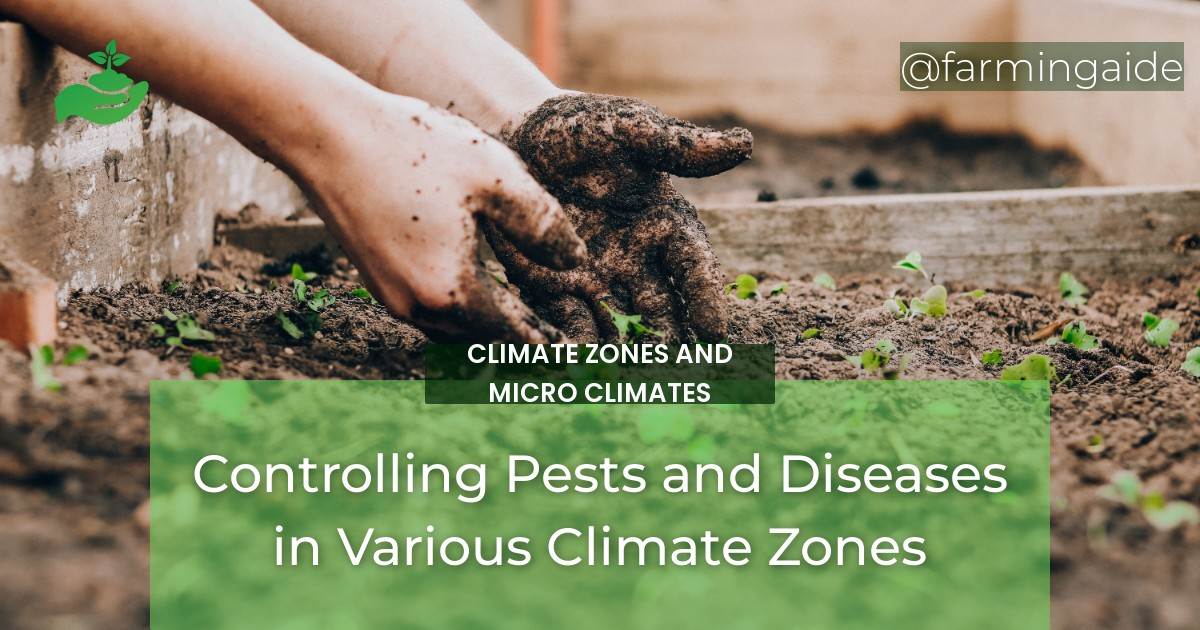Pests and diseases can be a major problem for farmers and gardeners alike, causing damage to crops, plants, and even the environment. The severity and types of pests and diseases vary greatly depending on the climate zone in which they occur. Therefore, it is essential to understand how to control these pests and diseases in different climate zones to ensure the health and productivity of plants. In this comprehensive article, we will explore the various types of pests and diseases that can be found in different climate zones and discuss effective methods for controlling them. From tropical to temperate regions, we will cover all the necessary information to help you protect your plants from these common threats. So, let’s dive in and learn how to manage pests and diseases in different climate zones.
Identifying Pests and Diseases
The first step in controlling pests and diseases is to be able to identify them. Different pests and diseases thrive in different climate zones, and their appearance and behavior may vary as well. Some common pests to look out for include insects such as aphids, caterpillars, and whiteflies, as well as rodents, birds, and other animals. Diseases, on the other hand, can be caused by bacteria, fungi, viruses, and even environmental factors like humidity and temperature. It is crucial to be able to recognize the signs of infestation or disease so that you can take the necessary steps to control them.
Signs of Pest Infestation
Some signs that may indicate a pest infestation include:
- Holes in leaves or fruits
- Discoloration or wilting of plants
- Presence of eggs, larvae, or adult insects on plants
- Bite marks on fruits or vegetables
- Visible damage to plant stems or roots
It is also essential to regularly check your plants for any signs of pests, as catching an infestation early can prevent it from spreading and causing significant damage.
Signs of Disease
Here are some common signs that may indicate a plant disease:
- Discoloration or spotting on leaves
- Wilting or drooping of plants
- Stunted growth
- Presence of mold or mildew on leaves
- Rotted or decaying plant tissues
It is crucial to act quickly if you notice any signs of disease, as they can quickly spread and cause significant damage to your plants.
Controlling Pests and Diseases in Different Climate Zones
ALSO READ
Tropical Climate Zones
Tropical climate zones are characterized by high temperatures and rainfall, making them ideal environments for pests and diseases to thrive. Some common pests found in tropical regions include termites, aphids, and mealybugs. These pests can cause significant damage to plants, including wilting, leaf drop, and even death. In addition, diseases such as leaf spot, root rot, and blight are prevalent in tropical zones due to the warm and humid conditions.
To control pests and diseases in tropical regions, here are some effective methods to consider:
- Regularly inspect plants for signs of pests and diseases
- Use natural predators such as ladybugs and praying mantises to control pest populations
- Implement crop rotation to prevent diseases from spreading
- Use organic and natural pesticides and fungicides
- Keep plants well-watered and fertilized to promote healthy growth and prevent stress
It is also essential to maintain good hygiene practices, such as removing dead plant debris and disinfecting gardening tools, to prevent the spread of diseases.
Temperate Climate Zones
In temperate climate zones, pests and diseases can be a problem year-round, but they are most prevalent during the warmer months. Insects such as beetles, grasshoppers, and slugs are common pests in temperate regions, while diseases such as powdery mildew, blight, and rust are prevalent. These pests and diseases can cause damage to a variety of plants, including fruits, vegetables, and ornamentals.
To control pests and diseases in temperate zones, here are some effective methods to consider:
- Use physical barriers such as row covers and netting to protect plants from pests
- Encourage natural predators such as birds and spiders to control pest populations
- Practice crop rotation to prevent diseases from spreading
- Use organic and natural pesticides and fungicides
- Keep plants well-watered and fertilized to promote healthy growth and prevent stress
ALSO READ
Arid Climate Zones
In arid climate zones, pests and diseases can be less of a problem due to the hot and dry conditions. However, some pests, such as mites and grasshoppers, are prevalent in these regions. Diseases are less common in arid zones, but some fungal diseases, such as root rot and powdery mildew, can still occur.
To control pests and diseases in arid zones, here are some effective methods to consider:
- Provide plants with adequate water and nutrients to prevent stress and make them less susceptible to pests and diseases
- Use natural predators to control pest populations
- Implement proper drainage to prevent the buildup of excess moisture, which can lead to disease
- Use organic and natural pesticides and fungicides if necessary
It is also crucial to regularly inspect plants for signs of pests and diseases and take action immediately if any are found.
Conclusion
Pests and diseases can pose a significant threat to plants in different climate zones, but with the right knowledge and methods, they can be effectively controlled. It is essential to be able to identify common pests and diseases and implement proper prevention and control techniques to protect your plants. By following the guidelines discussed in this article, you can ensure the health and productivity of your plants, no matter what climate zone you are in.
RELATED ARTICLES:


